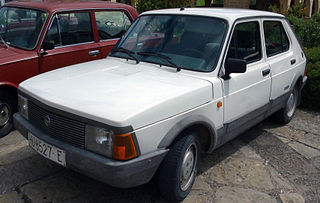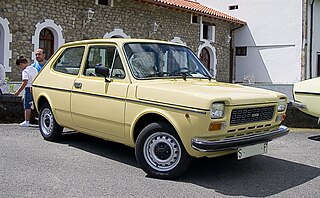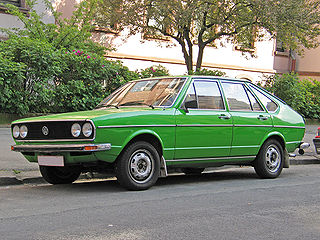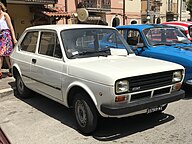
The Fiat 127 is a supermini car produced by Italian car manufacturer Fiat from 1971 to 1983. It was introduced in 1971 as the replacement for the Fiat 850. Production of the 127 in Italy ended in 1983 following the introduction of its replacement, the Fiat Uno, although the nameplate continued to be used on cars imported from Brazil.

The Fiat Uno is a supermini manufactured and marketed by Fiat. Launched in 1983, the Uno was produced over a single generation in three and five-door hatchback body styles until 1995 in Europe — and until 1 January 2014, in Brazil. Designed by Giorgetto Giugiaro of Italdesign, the Uno strongly recalled the high-roof, up-right packaging of Giugiaro's 1978 Lancia Megagamma concept, in a smaller configuration.

The Opel Ascona is a large family car that was produced by the German automaker Opel from 1970 to 1988. It was produced in three separate generations, beginning with rear-wheel-drive and ending up as a front-wheel drive J-car derivative.
Innocenti was an Italian machinery works, originally established by Ferdinando Innocenti in 1933 in Lambrate, a neighborhood on the eastern outskirts of Milan. Over the years, they produced Lambretta scooters as well as a range of automobiles, mainly of British Leyland origins. The brand was retired in 1996, six years after being acquired by Fiat.

The Fiat Tempra is a small family car produced by the Italian automaker Fiat from 1990 to 1996 in Italy. The Tempra was intended as a replacement for the Fiat Regata. The original project was called Tipo 3, being a mid-size car between the Fiat Tipo and the bigger Fiat Croma. The Tempra shares its Type Three platform with the Lancia Dedra and Alfa Romeo 155.

The Fiat 131 is a family car manufactured and marketed by Fiat from 1974 to 1984 after its debut at the 1974 Turin Motor Show. Available as a two-door and four-door saloon and 5-door estate across a single generation, the 131 succeeded the Fiat 124.

The Peugeot 305 is a medium-sized car produced by the French automaker Peugeot from 1977 to 1989. It was offered as a four-door saloon, five-door estate, and as a three-door van derivative.

The SEAT Fura is a supermini car which was produced by Spanish car manufacturer SEAT between 1981 and 1986, and based on the Fiat 127, which had been built by the firm since April 1972.

The SEAT 127 is a supermini produced by the Spanish automaker SEAT between the spring of 1972 and 1982, based on the Fiat 127.

The SEAT 131 is a rebadged Fiat 131, a mid-size family car, produced by the Spanish car manufacturer SEAT from 1975 to the middle of 1984. The SEAT 131 was presented in May 1975 in the Barcelona Motor Show.

The Fiat Fiorino is a small commercial vehicle produced by the Italian car manufacturer Fiat since 1977. Its first two generations have been the panel van derivatives of other small models, such as the Fiat 127 and Fiat Uno, while the current third generation was developed jointly with PSA Peugeot Citroën, and is based on the Fiat Small platform.

The Toyota Carina line of large family cars was introduced in Japan in 1970. It was introduced in Europe in 1971, with A40 and A60 series subsequently appearing soon after their introductions in Japan. In 1984, the A60 series Carina was replaced in the European market by the "Carina II" - essentially a rebranding of the T150 series Toyota Corona launched the previous year in Japan, with some minor alterations to suit the European markets. This trend of Coronas rebadged as Carinas produced for the European market continued for two more generations, with the second Carina II in 1988 and the Carina E in 1992.

The Volkswagen Passat (B1) is a large family car produced by Volkswagen in West Germany from 1973 to 1981.
Sipani Automobiles Ltd. was an Indian car manufacturer established in 1973, located in Bangalore. They mainly manufactured subcompact cars with fibreglass bodies. They also took over Auto Tractors Limited in 1991 and manufactured diesel engines and tractors in the old ATL factory in Pratapgarh, Uttar Pradesh.

The Farus is a mid-engined sports automobile built in Brazil by Industria de Veiculos Esportivos LTDA beginning in 1979. The Farus company, located in the southern Brazilian city of Belo Horizonte, was founded in 1979. The name of the company is a portmanteau of FAmilia RUSso, as the cars were built by Alfio Russo and his son Giuseppe. Their original mid-engined ML and TS cars were followed by the larger Farus Quadro, which was also part of an abortive effort to be sold in the United States. After a change of name to TECVAN, the company shut its doors in 1990 as a result of the Plano Collor market liberalization.

Designed by Aurelio Lampredi, the Fiat 124 engine first appeared in the all-new Fiat 124 in April 1966. The in-line four-cylinder engine comprised an iron block with an aluminium cylinder-head with pushrod actuated valves. The belt-driven design was ahead of its time when introduced. European production of the petrol versions ended with the Fiat 131 in 1984, but later diesel derivatives continued to be built until 1999. It did have a longer life in its twin-cam iteration, which continued in production until 2000. While originally of an overhead valve design, an overhead cam version was added to the facelifted 131 in 1981. The capacity was initially 1.2 L (1,197 cc), but eventually ranged between 1.2 and 1.9 L. There were also three SOHC diesel iterations of 1.4, 1.7, and 1.9 litres. The last versions of this engine to be built were the diesels. The 1.9 L (1,929 cc) direct-injected diesel version was the first direct-injection diesel to appear in a production passenger car, the Fiat Croma Turbo D i.d.
The Daihatsu C-series engine is a range of compact three-cylinder, internal combustion piston engines, designed by Daihatsu, which is a subsidiary of Toyota. The engines range from 843 to 993 cc and have been manufactured in petrol and diesel-driven series. They have cast iron engine blocks and aluminum cylinder heads, and are of either SOHC or DOHC design, with belt driven heads. The engine first appeared in the all-new Daihatsu Charade in October 1977, in "CB20" form.

The Opel Kadett E was introduced in August 1984, and was the sixth generation of the Opel Kadett, and was voted the 1985 European Car of the Year. As with its predecessor, it was sold as the Vauxhall Astra in the United Kingdom. This model was also developed into a more conventional three-box design with a boot (trunk), badged as the Vauxhall Belmont in the United Kingdom, launched at Frankfurt 1985. There was a station wagon called the "Caravan", available with either three or five doors. In South Africa, the Kadett notchback was sold as the Opel Monza, along with a convertible. This replaced the Opel Ascona.
Designed by Aurelio Lampredi, the Fiasa engine first appeared in the Brazilian-built Fiat 147 in September 1976. The name Fiasa is a portmanteau of "Fiat Automóveis S.A.", for whom it was developed. The in-line four-cylinder engine has five main bearings, a cast iron block with an aluminium cylinder-head with belt-driven overhead camshafts actuating the valves. The engine remained in production until 2001 in Latin America, and also provided the basis for a diesel version. The capacity was initially 1.0 L (1,049 cc), but Lampredi designed the engine to be suited for a considerably longer stroke. Sizes eventually ranged between 1.0 and 1.5 L. The last versions of this engine to be built was a 1.5-litre, dedicated-ethanol version developed in Brazil that served the Fiat Uno and its derivatives, and later yet the Fiat Palio until 2001.






















